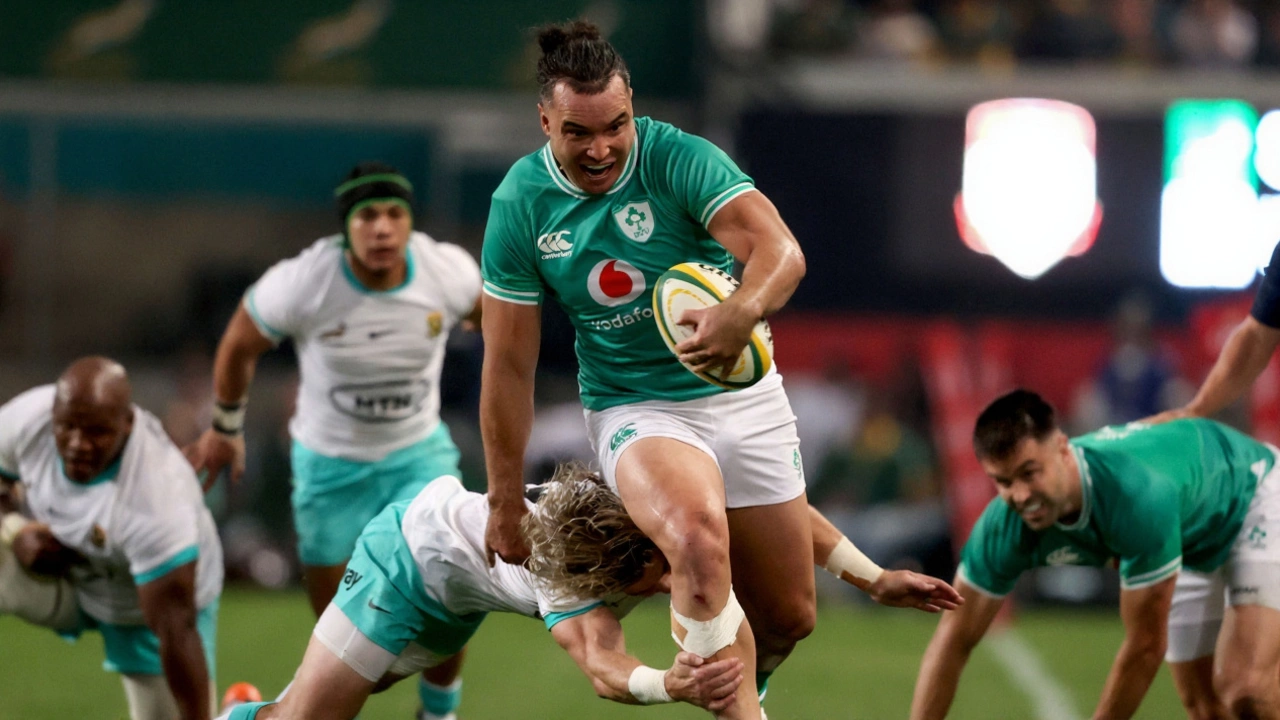When Andy Farrell walked into the post-match press conference at the Aviva Stadium on November 23, 2025, the air was thick with frustration. Ireland had just lost 31-17 to South Africa in a match that felt more like a courtroom drama than a rugby game. Three Irish players—fly-half Sam Prendergast, Jack Crowley, and prop Andrew Porter—were sin-binned in the final 12 minutes of the first half. For nearly ten minutes, Ireland played with just 12 men. The Irish Rugby Football Union (IRFU) coach didn’t flinch. "They showed bottle for their country in a chaotic situation," Farrell said, his voice low but steady. And that, more than the scoreline, is what stuck with everyone who watched.
The Turning Point Nobody Saw Coming
It wasn’t the tries. It wasn’t even the final whistle. The match turned when referee Matthew Carley of England, officiating under World Rugby, awarded a penalty try after a series of scrum collapses that left Ireland’s front row in disarray. Carley ran under the posts—not just to signal the try, but to make a statement. The crowd fell silent. The Irish bench stared at the ground. South Africa’s lead ballooned from 12-7 to 19-7 at halftime, and they never looked back. Farrell didn’t blame the players. He blamed the mistakes. "A few stupid errors from ourselves playing the ball through the ruck, and I think with three offside penalties. They’re the manageable ones that you don’t give a team like that access, but we did," he said. It wasn’t just discipline—it was timing. Ireland had been winning the breakdowns, forcing turnovers, even scoring a try that was later chalked off for a forward pass. "You can look at all sorts of different situations," Farrell added, "but that try being called back? That was the turning point."Refereeing Under the Microscope
The controversy didn’t end with the final whistle. South Africa had been vocal before the match. Just days earlier, flanker Lood de Jager had been sent off against France on November 9, 2025, a decision that stuck and cost him two weeks. Then, veteran lock Franco Mostert was red-carded against Italy on November 16, only for the suspension to be overturned on appeal. Ireland’s coaching staff raised it with Carley before kickoff. "We brought it up with the referees before the game," Farrell said, "and they said that would never be a factor because this is a separate game—and I’ll let you be the judge of that." The implication was clear: South Africa felt targeted. Ireland felt unfairly scrutinized. And Carley, the English official, became the lightning rod. His decision to sin-bin Prendergast—a 22-year-old with just five or six caps—was especially contentious. Was it a yellow? Or should it have been red? Farrell’s response was sharp: "You are asking the question because you thought so as well."
The Human Cost of Chaos
Prendergast, described by analysts as a "heavy set" fly-half with raw aggression but still developing his decision-making under pressure, was the emotional core of Ireland’s collapse. One commentator noted: "He’s so good. I can see he has moments where he’s got that aggression and competitiveness." But in the face of relentless South African pressure and a referee’s whistle that seemed to ring like a dinner bell, his composure cracked. His yellow card came after a failed clearance pass—exactly the kind of moment that defines young players. And now, he’s under the microscope. Meanwhile, South African media didn’t hold back. "Like the Terminator, they refused to die," read one headline. They praised Ireland’s "Gaelic mischief"—the clever, unorthodox counter-rucking, the steals at the breakdown that had kept them in the game despite the numbers disadvantage. But in the end, South Africa’s physicality and composure in the second half proved too much. Their captain, Siya Kolisi, led by example: 18 tackles, 11 carries, zero penalties. That’s the difference between winning and losing when the game turns ugly.What This Means for Ireland’s Future
Farrell’s team now faces a reckoning. The IRFU’s high-performance unit will review every tackle, every ruck, every referee’s call. But more than tactics, they need culture. This wasn’t just about discipline—it was about control. When you’re down to 12 men, the game doesn’t just get harder. It gets psychological. And Ireland’s players, for all their grit, looked rattled. The fly-half position is now the biggest question mark. Prendergast’s talent is undeniable. But can he handle the pressure? Will Farrell stick with him, or turn to the more experienced Johnny Sexton, who’s still training but hasn’t played since the summer? And what about the scrum? If Ireland can’t stabilize their set-piece, they’ll keep giving referees the excuse they need to punish them.
What’s Next?
Ireland’s next match is against New Zealand in Dublin on December 7, 2025. If Farrell doesn’t fix the discipline, the All Blacks will eat them alive. But if he can instill calm in chaos, this defeat might become the foundation of something greater. Because rugby isn’t just about winning. Sometimes, it’s about how you stand when the world is falling apart around you.Frequently Asked Questions
Why was Sam Prendergast’s yellow card so controversial?
Prendergast’s yellow card came after a high tackle following a failed clearance pass—his second mistake in as many minutes. While not a clear red-card offense, the timing was catastrophic: Ireland was already down a man, and the referee chose to escalate. With only five international caps, Prendergast is still learning to manage pressure, and this moment exposed his vulnerability under elite scrutiny. Many analysts believe it should have been a warning, not a sin-bin.
Did Ireland have a legitimate case about biased refereeing?
Yes. South Africa had already faced two controversial red cards in the same November window—Lood de Jager against France (upheld) and Franco Mostert against Italy (overturned). Ireland raised this with match officials before kickoff, and Farrell’s comment—"I’ll let you be the judge of that"—implies they felt their concerns were dismissed. While no official bias was proven, the pattern suggests a perception problem within World Rugby’s officiating culture.
What role did the scrum play in the match outcome?
The scrum was the flashpoint. Ireland’s front row conceded four penalties in the first half, leading to the penalty try and multiple yellow cards. While South Africa’s scrum was dominant, Ireland’s technical errors—especially in binding and foot placement—gave referee Matthew Carley clear grounds to punish them. Analysts noted Ireland’s scrum had been solid in previous matches, suggesting this was a performance collapse, not a structural flaw.
How did South Africa’s tactics differ from Ireland’s?
South Africa played with chilling efficiency: they punished mistakes, stayed disciplined, and didn’t panic when Ireland stole the ball. Their defense was relentless, with Siya Kolisi leading 18 tackles. Ireland, by contrast, relied on flair and counter-rucking—what South African media called "Gaelic mischief"—but lost control under pressure. Where Ireland tried to outthink, South Africa outlasted.
Will Andy Farrell change his fly-half selection for the New Zealand match?
It’s unlikely. Farrell has publicly backed Prendergast, calling him "a future leader." But he may bring in Johnny Sexton as a tactical substitute to stabilize the game in the final 20 minutes. The bigger issue isn’t the player—it’s the system. Ireland needs to train better under pressure, not just replace the man.
What does this mean for World Rugby’s officiating standards?
This match has reignited calls for a review of how referees handle high-pressure games. The fact that three yellow cards were issued in the final 12 minutes of a half, with one leading to a penalty try, suggests inconsistency in application. World Rugby must clarify thresholds for sin-bins versus warnings, especially for young players in high-stakes matches. Otherwise, the game risks becoming a lottery.
